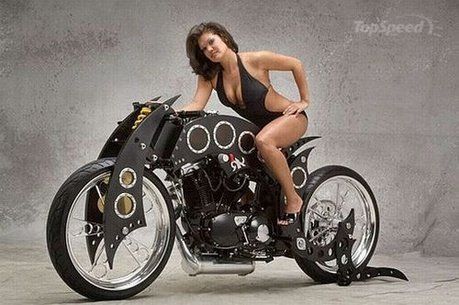
In the waning days of the Vincent Motorcycle Co, 1955 to be exact, the producers of the film adaptation of George Orwell's classic
'1984' utilized the services of the
Vincent Owner's Club to provide a chilling mobile Thought Police force, filming their nearly-new Vincents in a bombed-out area behind Guildhall, London. The photograph
above is from the September 1, 1955 issue of
The Motor Cycle, which has a small feature on the motorcycles in the film.
The Thought Police, keepers of order and maintaining correct speech, thought, and behavior (the ultimate P.C. brigade - and did you know the term
'politically correct' comes from the Chinese Cultural Revolution in the 1960's?), rode the most sinister and imposing motorcycle available; Vincent Black Knightss (or Princes - can't tell the difference in the film, as the bike's identity has been removed; common before the days of 'pay for play' product placement in the movies). Vincent's new-for -'54 models had full fiberglass enclosure and fairings, and in their all-black guise from the factory certainly gave an impression of menace, which may look ungainly now, but in the day, was certainly futuristic and slightly unnerving
(see below).
 George Orwell
George Orwell was born Eric Blair, son of an English civil servant in Bengal, India. He was sent home to England for school; his prowess shone and he was given scholarships, landing him at historic Eton, where he evidenced a disrespect for the authority of his teachers (later writing the essay 'Such, Such Were the Joys' about his early school days). With his 'poor attitude', no scholarship for university study was forthcoming, and he joined the Indian Imperial Police, in Burma (India and Burma being colonies of England at that time).
(Orwell can be seen below, the tall one!)
He grew to hate Imperialism, writing several essays at the time deeply critical of the hyporcrisy and brutality he witnessed (his first novel was
'Burmese Days'). He took the pen name George Orwell at this time, after the patron Saint George of England, and the Orwell River in Suffolk county.

While in Burma, he learned to ride an American military motorcycle (don't know what make!), and is reputed to have hunted tigers on it, using his Luger Parabellum pistol! According to 'The Unkown Orwell' (Stansky & Abrahams, 1972), the bike had 'four cylinders fore and aft'; this would have been 1922, so the selection of possible machines is limited - perhaps an ex-military Henderson such as the 1918 model
above? Back in England, according to the same book, Orwell caught pneumonia while delivering the manuscript for 'Burmese Days' to his publisher, in the freezing rain on his motorcycle, December 1933.
The life of a writer was then as now a difficult financial path, and Orwell experienced waves of impoverishment, summarizing his experience in the 1930's (during the worst of the Depression) in his book
'Down and Out in Paris and London'. During this period of impecunity, he was occasionally homeless, contracted tuberculosis, refused to wear a warm overcoat, and was dogged by ill health for the rest of his short life.

In 1937, he volunteered to fight on the Republican side of the
Spanish Civil War (above, Orwell is the tall one, his wife sitting below), against
Franco's Fascists; Orwell joined the
POUM (Worker's Party of Marxist Unification), a far-left and anti-
Stalinist fighting group, which allied with the
Anarchists to fight both the Fascists AND the Communist party (supported by Stalin and his secret police, regularly attacked the Anarchists and POUM)

. In June 1937 he and his wife fled Spain, narrowly beating the Soviet secret service which sought to kill him for being a
Trotskyite. He shortly published the book
'Homage to Catalonia' about his experiences in Spain.

When WW2 began, he worked for the
BBC Eastern Service (above, with fellow writer T.S.Eliot), an easy fit due to his early years spent in India and Burma, writing copy to convince Indians and East Asians to support the British war effort. He spoke of feeling like
'an orange that's been trodden on by a very dirty boot' for his distaste at working as a propagandist. After quitting in 1943 to write with the left-wing
Tribune, he published
'Animal Farm', an allegory of Stalinist repression, in 1944, which was his first literary success.

From 1946-48 he lived in the village of Barnhill
(below), on the
island of Jura in Scotland while writing the novel
'1984', an allegory of totalitarianism,

and the use of language to shape thought and behavior. While living on Jura, he apparently rode an old Rudge ('four valves, four speeds' - an advanced bike... in 1926), which was noted as being unreliable in the extreme! A search for the motorcycle on Jura in later years reveals contradictory stories; one claims the Rudge was scrapped after being sold to a boat captain. Another tale by writer and cartoonist Jock Macneish claims the Rudge was left in a hedge when Orwell left, and it sits there on Jura, rotting, to this day!
(It's a great story, click here).
'1984', of course, became Orwell's best-selling and most famous book, with much of his language, peculiar to his vision of English Socialism (or
Ingsoc in the novel's 'Newspeak'), becoming part of everyday use even today - 'big brother', 'thought police', 'war is peace', etc, and the implied (and chilling) analysis that in modern war, "Victory is not possible; the war is not meant to be won, it is meant to be continuous...".
Orwell died of complications of tuberculosis at the age of 46, in 1950. He didn't live long enough to see the film adaptation of
'1984', nor the début of the Vincent Black Knight.
 (The above images are all 'copyleft', for non-commercial reproduction)
(The above images are all 'copyleft', for non-commercial reproduction)

































